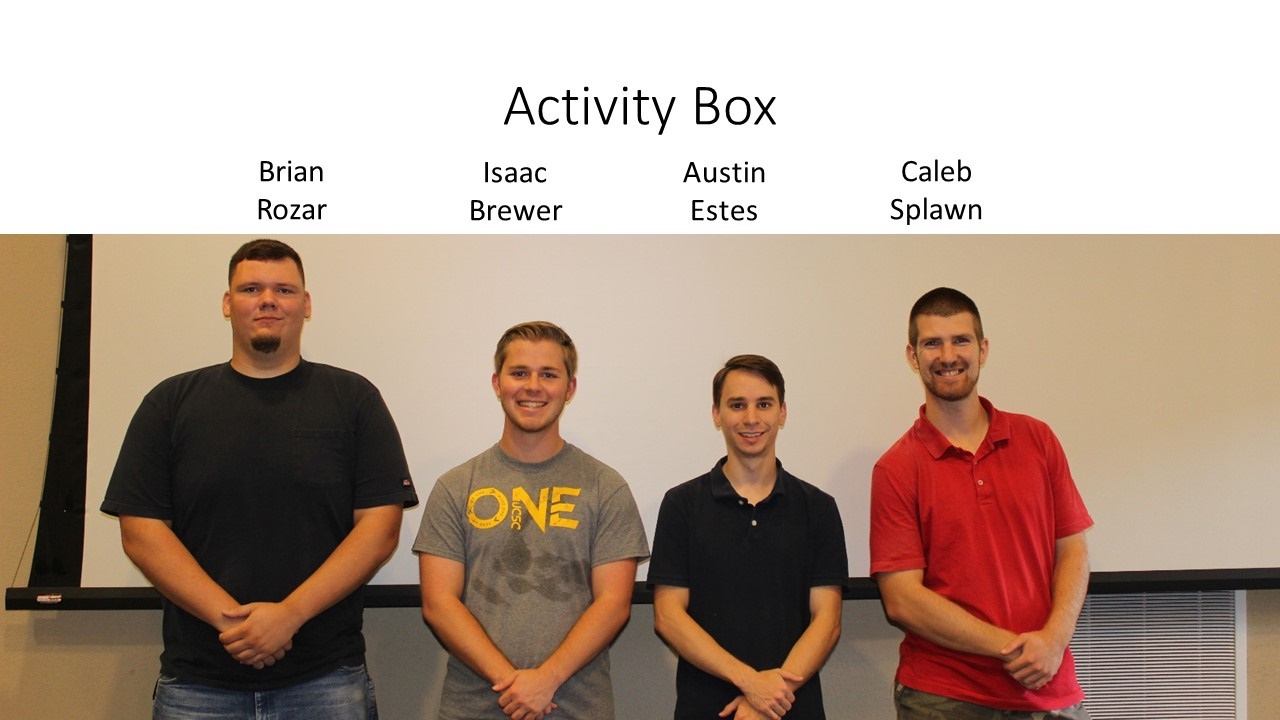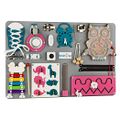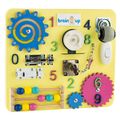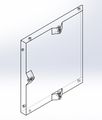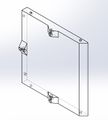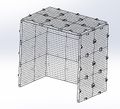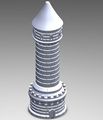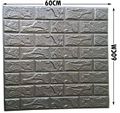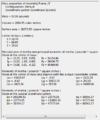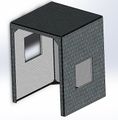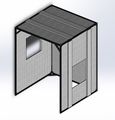Activity box
Abstract
A 3-year old child with down syndrome is in need of a activity box that provides fun toys and everyday objects to improve her hand manipulation. The box will not only aid in her fine motor skills, but also provide a practical understanding of the world around her. It needs to be creative and colorful to keep her engaged and for her to learn how to open small drawers, flip switches, and press buttons along with the ability to manipulate clothing features like zippers, buttons and shoelaces to work on getting dressed independently. Building this project will enhance her ability to be familiar with everyday objects and tasks, and so ensure her growth as a healthy and adaptive child.
Team members
Pictured: Brian Rozar, Isaac Brewer, Austin Estes, Caleb Splawn (left to right)
Additional Acknowledgements:
- Dr. Stephen Canfield
Problem Statement/Overview of the Need
A 3-year old girl with down syndrome needs an activity box that is entertaining and provides opportunities to practice and develop her hand manipulation. The design should be a board, cube or playhouse with surfaces that house numerous toys/objects of different varieties. The toys should focus on activities that use and improve hand movement with practical applications, such as buttoning to allow the girl to dress herself independently. The toy should also incorporate rewards for the girl rather than simple switches that provide no sense of accomplishment.
Design Specifications
Priorities Requested by Parents and Therapist
- Something involving vibration
- Zippers, buttons, clips
- Something to grasp with hands and rotate wrists (bendable tubing)
- Strings/something to tie
- Incorporate a “Magna Doodle” - can be removable
- An area to play with magnets
- Easy-to-access compartment for mom to perform any maintenance
- Box should allow child to walk in and reach upwards to develop muscles
- Objects should focus on improving pinching muscles
- Music should be used as a motivator
Additional Requests
- She likes drawing and colors
- She likes Mickey and Minnie Mouse
- Doorbell or buzzer
- Push buttons that light up
- Gear and Crank mechanism (possibly that opens a secret compartment)
- Incorporate learning language if possible
- Puzzle
- Toys should not be organized by category so that she does not have a “favorite” side
- Not too heavy
Background research
1) Similar, Existing Products
Activity boxes, or "Busy Boards," currently on the market showcase various mechanism attached to a wooden board or cube for a child's enjoyment and growth in motor skills. These mechanisms could include light switches, latches, door knobs, shoe laces, and other common household and everyday items. Ready-to-purchase boards are often very general, lack theme, and are not necessarily crafted for a specific child. On the other hand, there are also DIY boards on the market which gain the benefit of targeting a specific child's needs, but these products can see a steep increase in price.
2) Availability
Ready-to-purchase activity boxes or boards are available through Amazon or Walmart in the $50 - $300 price range. If a more specialized product is desired, one would need to contact a DIY service. Price can vary greatly depending on the size and material of the product as well as the types of mechanisms desired. Simpler designs exist in the $100 price range, while more complicated and specialized designs can reach up to $1000.
3) Improvements to the Current Market
Our product can greatly improve upon the current ready-to-purchase boards by offering a specialized product designed with a therapist's recommendations and parent's requests prioritized greatly. Another downfall in the current market is that most of the practical mechanisms do not offer a practical reward or teach the child the mechanism's purpose. For example, it is common in the current market to see a light switch that is not actually attached to a light bulb. Our product will offer practical mechanisms along with rewards which will allow the child to practice motor skills as well as learn the functionality of common mechanisms. The intent of our product is to provide all the benefits of a specialized, DIY activity box while maintaining a low cost. The only cost of our product will come from the material and the cost of the attached mechanisms.
Shown below are pictures of competitors' products.
Conceptual Design
Below are a list of three concepts for the activity box.
Design Concept 1
- Shape: (2'x2'x2') Cube with removable lid
- Material: 3-D Printed PLA (modular sections)
- Devices attached with Nut/bolt and super glue as needed
Description
This concept features a cube with mechanisms attached to the exterior of the cube. This option removes material cost, as the 3D printing material cost will be covered by the TTU iMakerSpace. The cube will be too large to print as one entity, thus the cube will be printed in modular sections which will be pinned and bolted together. The lid will be removable via screwdriver in order for any maintenance to be performed on the inside of the product. The product will be significantly lighter than any other material chosen, so additional weights can be added into the interior of the cube to prevent sliding or tipping during use. This concept will require significant planning and design before assembly begins; however, assembly will be very simple.
Design Concept 2
- Shape: (36"x24"x40") 3-Walled Structure with Open Front
- Material: 3D Printed PLA
- Devices attached with Nut/bolt and super glue as needed
Description
After further discussion with the occupational therapist, it was suggested that a high priority in the design should allow the child to stand inside the play space and reach upwards for toys or objects to improve balance and strength. This leads to a play house design rather than an activity board design. The interior of the walls and roof will be lined with toys and mechanisms. This design will feature 3 walls and a roof constructed from modular panels similar to Design Concept 1. It will be possible to add additional panels in increase the size of the box as the child grows. The panels will feature a grid of holes that match pegboard to be able to easily attach toys and mechanisms. Any wiring or battery packs will be located on top of the roof out of reach of the child, but easily accessible for the parents. The 3D printed material will remove material cost, as the 3D printing material cost will be covered by the TTU iMakerSpace. However, assembly time of the structure will be significantly large due to the size of the structure.
Design Concept 3
- Shape: (36"x36"x40") 3-Walled Structure with Open Front
- Material: Wood
- Devices attached with screws as needed
Description
The design for this concept will feature a sturdy wooden frame with pegboard attached to the insides and outsides. We will include additional panels to be attached to the frame via cam connectors; this will allow the box to grow with the child. This design will also feature a wooden floor and roof to provide more stability to the structure. Because of this increased stability, more features can be added such as stairs and/or a ladder so that the child can climb on top of the box and then slide down the other side. This will allow the child to develop gross motor skills as well as fine motor skills.
NOTE: All design concepts will involve practical, rewarding mechanisms to enhance motor skills with a focus on pinching (zippers, velcro puzzle, gears, etc.)
Evaluate Concepts/Select Candidate
Scale 1-5 ( 5 = Best )
| Concept 1 | Concept 2 | Concept 3 | |
|---|---|---|---|
| Affordability | 5 | 4 | 3 |
| Portability | 5 | 3 | 2 |
| Aesthetics | 3 | 3 | 4 |
| Ease of Use & Maintenance | 3 | 4 | 4 |
| Durability | 2 | 2 | 5 |
| Assembly Time | 2 | 1 | 4 |
| SUM | 20 | 17 | 22 |
Selected Candidate: Concept 3
Concept 3 appears to be the best choice. It allows the child to walk into the box and reach upwards and also features good durability with a practical assembly time.
Detailed Design
Description of selected design
Our final design will closely resemble Design Concept 2, but with improvements made to the Durability and Assembly Time categories. The box dimensions will be 3'x3'x4' and it will act as a playhouse or fort with 3 walls and a roof. The interior of the playhouse will have many toys attached whose purpose are to improve fine motor skills in a fun, interactive manner. The interior and exterior of the playhouse will be decorated with a Mickey and Minnie Mouse theme. The structure will feature a window on each wall to provide light and also make it feel more like a playhouse than a cave.
Detailed description of selected design
The framework of the playhouse will be constructed of 80/20 extruded aluminum with pegboard slotted into the framing to house the toys. The use of aluminum for the frame will provide increased durability while also reducing assembly time due to the many readily available connectors and braces for 80/20. The toys will be attached to the pegboard with a mixture of screws, glue, and zip ties depending on each specific toy. We will use a color scheme of red, black, and white. The exterior will resemble a castle with gray brick, pillars, and castle walls.
Analysis
Our analyses investigated the stress and deformation of the pegboard, statics of the entire playhouse, and the methods to attach the toys.
Engineering Analysis 1
Stress and Deflection of Pegboard
The purpose of this analysis is to determine the maximum stress and deflection of the roof under a load similar to someone sitting on the structure.
Stress:
The roof was simplified to a 2D, simply supported beam with a load applied directly at the center of the beam.
Maximum stress was estimated based on research of different types of wood's Modulus of Rupture. It was found that 6000psi - 8000psi was the low end of the spectrum for woods. We further reduced this maximum stress by 50% to better estimate the MDF board. Using 3000psi as the maximum stress results in a maximum allowable force of 70.3 lbs.
Note: This does not take into account any stress concentrations due to the holes of the pegboard.
Deflection: This study is to determine the maximum allowable force on the pegboard before it "pops out" of the framing. As shown, the deflection curve was simplified to be linear. Similarly to the stress analysis, a low-end Modulus of Elasticity was chosen and then further reduced by 50%. The Modulus of Elasticity used was 6x10^5 psi. With a span (Length) of the pegboard as 34.5 in. and a Δl of .25 in. the maximum allowable force applied at the center is 39.2 lbs.
Conclusion: We will need to add stiffening beams to the roof and walls of the structure to prevent the pegboard from popping out or breaking under heavy loads. We will use 1x4 wood strips as the stiffening beams.
Engineering Analysis 2
Statics of Structure
The purpose of this analysis is to determine the structure's center of gravity and tipping conditions.
SolidWorks was used for the Center of Gravity study. The weight was determined as approximately 92 lbs at 13.72 in., 18.04 in., 28.61 in. (x,y,z) excluding the mass of the toys.
The structure will topple when it is tipped left-to-right at an angle of 32.2 degrees relative to vertical or front-to-back at an angle of 25.6 degrees relative to vertical.
When starting from rest, the structure will begin to tilt when a force of 34.5 lbs is applied directly at the top of the structure, perpendicular to the walls.
Engineering Analysis 3
The purpose of this analysis is to evaluate the proposed toy attachment methods.
Screws/bolts: This will be the strongest method of attachment. Each individual toy's weight will not exceed more than a few pounds. As such, there is no concern of shearing the bolt. After some research, it was found that the required withdrawal force for a screw in wood is approximately at least 100lbs. This means there is also no concern of pulling the screws out of the wood.
Adhesive: It was found that most super glues and wood glues can achieve several thousand psi of shear strength depending on the two adhered materials. We estimated a shear strength of 1000psi for wood-to-wood or wood-to-plastic connections. However, the peel strength of some super glues was found to be approximately 15lb/in for an aluminum-to-aluminum connection. We reduced this peel strength to 10lb/in to better approximate our materials.
Zip Ties: Standard zip ties have an approximate maximum load of 50lbs. Heavy duty zip ties have an approximate maximum load of 120lbs. This means that there is not a concern for breaking any zip ties used to attach the toys, especially if we use more than 1 zip tie.
Conclusion: We should be wary of relying solely on adhesive to attach the toys. If a peeling force is applied, it could be relatively easy to break the adhesive.
CAD Drawings
Bill of Materials
| Item | Description | Source | Part Number | Price | Quantity | Total |
|---|---|---|---|---|---|---|
| 80/20 - 8ft | 20mm width | McMaster-Carr | 5537T101 | $22.36 | 2 | $44.72 |
| 80/20 - 3ft | 20mm width | McMaster-Carr | 5537T101 | $10.38 | 7 | $72.66 |
| Brace | 1" length | McMaster-Carr | 5537T81 | $5.39 | 16 | $86.24 |
| Brace - Extended | 6" length | McMaster-Carr | 5537T2 | $17.12 | 4 | $68.48 |
| Pegboard | 3/16" | Lowes | 15484 | $19.93 | 4 | $79.72 |
| 1x4 Wood | Stiffening Beams | Lowes | 4510 | $2.18 | 4 | $8.72 |
| Decorative Stickers | Stone Brick Pattern | Amazon (POPPAP) | POP667176381908 | $69.99 | 1 | $69.99 |
| 3D Printed Tower/Walls | Decorations | iMakerSpace | -- | $6.25 | 4 | $25.00 |
| Wooden Alphabet puzzle | Toys | Walmart | -- | $7.99 | 1 | $7.99 |
| Wooden numbers puzzle | Toys | Walmart | -- | $5.79 | 1 | $5.79 |
| Brass lock | Motor skill | Walmart | -- | $2.27 | 1 | $2.27 |
| Door knob | Motor skill | Walmart | -- | $11.57 | 1 | $11.57 |
| Fabric Bracelet | Toy | Walmart | -- | $2.39 | 1 | $2.39 |
| Wooden Animals puzzle | Toy | Walmart | -- | $11.04 | 1 | $11.04 |
| Flexible Twist | Toy | Walmart | -- | $4.86 | 1 | $4.86 |
| Light Switch | Toy | Walmart | -- | $0.67 | 1 | $0.67 |
| Magnadoodle | Toy | Walmart | -- | $14.97 | 1 | $14.97 |
| Shape Puzzle | Toy | Walmart | -- | $12.99 | 1 | $12.99 |
| Massage Pad | Toy | Walmart | -- | $35.99 | 1 | $35.99 |
| Plastic Tubing | Toy | Walmart | -- | $2.59 | 3 | $7.77 |
| Jacket | Toy | Goodwill | -- | $9.99 | 1 | $9.99 |
| Shoe Laces | Toy | -- | -- | Free | 1 | Free |
Total = $_583.82_
Assembly Instructions
Due to the size of the structure, some assembly will be required at the delivery location. The left and right walls will be fully assembled in the frame; the ceiling and back wall will need to be assembled into the frame on site. Our group will provide the assembly work so that no work is necessary for the recipient family. Batteries are included for each toy, but the batteries may need to be replaced overtime due to normal use. When possible, toys were attached with zip ties or other easily removable forms of attachment in the case that a toy needs to be replaced or moved. As the child grows taller, yarn/string that hang toys from the ceiling should be shortened accordingly to ensure the hanging sensory items are barely within the child's reach to promote stretching and reaching.
Fabrication Process
Photographer: Austin Estes
Testing and implementation
Testing: Toys were tested before and after being attached to the pegboard to ensure working condition.
Delivery: The product was delivered and installed at the family's house on 12/10/2018.
Use: This product is to be used by the three-year-old girl to improve hand and wrist manipulation and to encourage her to reach and extend her arms.
Photos of Completed design
Instructions for safe use
- Do not exceed a load of 40 lbs on roof of structure.
- Only use the attached devices as toys. Do not use structure itself as a toy.
- Do not climb on or hang from ceiling.
- Keep away from direct heat.
- Do not use the device unless supervised by an adult that has been fully instructed in the safe use of this product.
Project Summary, Reflection
This project helped us with both hands on experience and real engineering calculations. It was especially beneficial to calculate the maximum allowable load, add stiffening material to increase this load, and then test the actual product to see that the stiffening did in fact work as intended. This project helped us focus on and plan all small details before the assembly phase in order to make assembly run more smoothly. It also exposed us to some unforeseen issues that we had to correct on-the fly, which is part of almost any real project. The best part of the project was seeing the family's reaction to the project. We liked seeing the little girl's enjoyment as she first stepped into the fort.
